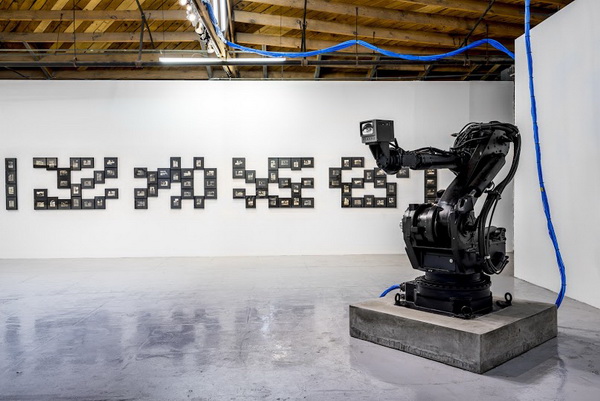With an observer’s detachment in the face of dire predictions of humanity’s demise from the rapidly developing field of artificial intelligence (AI), in “The Earth is Flat,” James Georgopoulos lifts from a trove of pop culture imagery adapted from film and other sources, constructing tableaux that feel familiar. The exhibit is a collection of sleek, industrially fabricated sculptural objects, an array of photographs printed from vintage negatives and hand-detailed, and one Finish Fetish influenced object.
Georgopoulos has worked in the movies as an art director; his sculpture shifts between tableau and prop, and the gallery in his hands could be a set. Zeus (all works 2016), his ersatz quantum computer meant to evoke Deep Blue, the IBM machine that defeated international Chess champion Gary Kasparov in a 1996 match, is perhaps more aptly compared to the Hal 9000 whose sinister presence is inescapable and ultimately unassailable in Stanley Kubric’s 2001: A Space Odyssey (1968).
Actually a double metal cabinet embedded with speakers and faced with two rows of blinking lights and matching monitors displaying unintelligible code, Zeus’ speakers emit a low frequency pattern that is unmistakably meant to sound like a heartbeat to convey that artificial intelligence is an incipient life form, poised, like Zeus, to overthrow his Titan forebears and imprison them (us) in an abyss. Like Kubric’s depiction of the Hal 9000 as ominously omnipresent, Zeus’ heartbeat delivers a sense of threat that pervades each of MAMA’s galleries.

James Georgopoulos, Zeus, 2016. ©James Georgopoulos, Courtesy of MAMA Gallery, Los Angeles.
Other sculptures, likewise, are multivalent. Georgopoulos personifies AI with Luddite, once part of an assembly line robot in Detroit, made to replace humans. Its video screen—at the end of a robotic arm—projects the image of a human eye, rather than the sensors a machine would use to gather data. Bundles of blue CAT5 cable—inert in this installation—connect Zeus; Luddite; Weight Watcher, a security cam embedded on a 1940s fridge that captures and broadcasts video of anyone standing in front of it; and Autonomous X12, a sculptural video work that evokes autonomous cars. The unnerving suggestion of these machines networked together and collaborating—observing humans for subjugation or analysis—is offset by the artifice.
The “Human Behavior” series, six arrays of hand-toned photographs, was made from negatives purchased on eBay. The subjects, mostly women walking alone or in pairs—though in a few cases, there are more than two, or the group is mixed—were photographed without their awareness. The prints are overlaid with a pattern in metallic automotive finish, as if to suggest data embedded with the visual record of human interaction. The title suggests an artificial or machine intelligence indexing human behavioral patterns. The photos, however, probably made in the 1960s, betray a predatory impulse, and as artifacts chillingly eclipse any fiction—or forecast—this exhibit creates concerning a future of machine supremacy. Whether this impending epoch will be a boon to humanity or the beginning of a new dark age, as some eminent technologists warn, is left for us to ponder.


